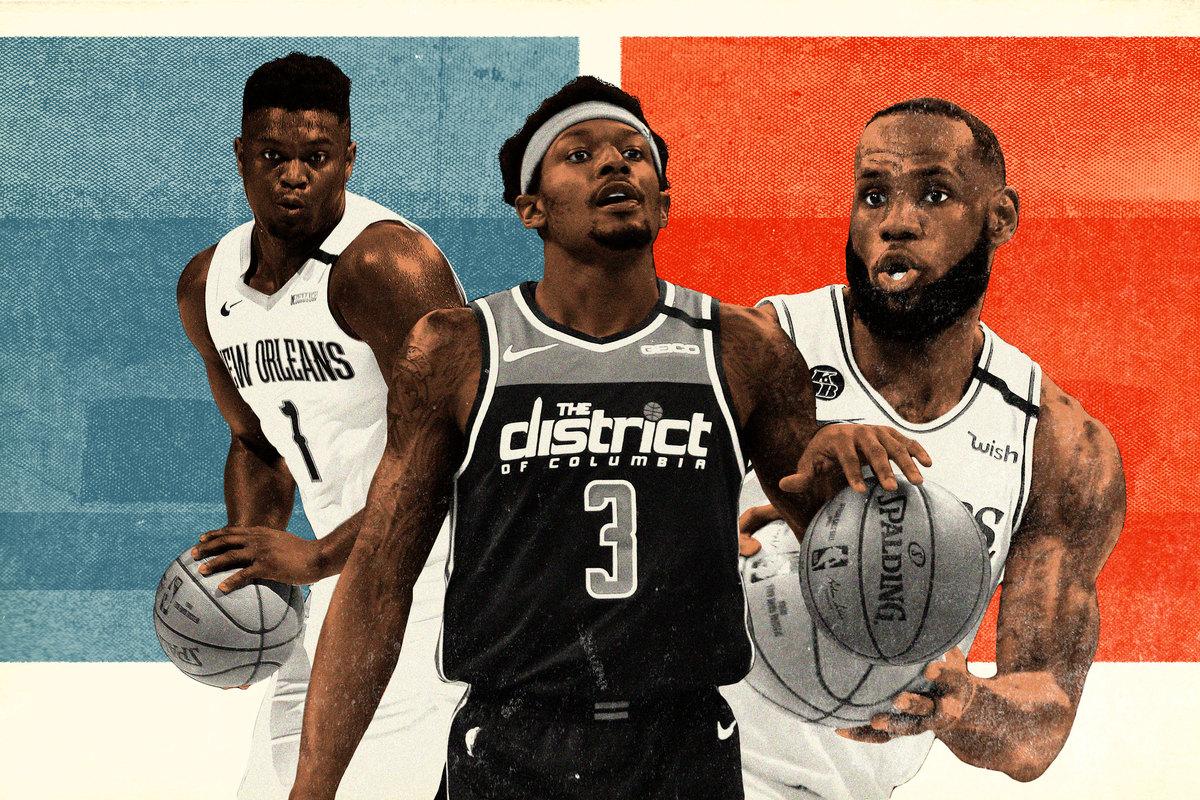
The NBA is coming back. According to reports by ESPN and The Athletic, the league plans to send 22 teams to Orlando—the top 13 from the Western Conference and top nine from the Eastern Conference—for an eight-game regular season beginning on July 31, followed by a postseason. The playoffs will follow the traditional format (four rounds, the top eight teams from each conference, etc.), except a play-in tournament will be held between the ninth- and eighth-place teams if the two are within four games or fewer in the standings by the end of the regular season. If all goes well—including a board of governors call on Thursday to make the plan official—the last possible date of a Finals Game 7 is October 12.
Here are the major takeaways as we wait for the decision to be approved and the games to restart:
The World Gets More Zion
Paolo Uggetti: The long-running joke (conspiracy theory?) throughout the NBA’s complicated quest to return has been that the league will do whatever it takes to include Zion. If it wasn’t the main reason to bring more than just the 16 playoff teams to Orlando, it was at least a factor (got to get those TV ratings). By settling on a format that includes regular-season games plus a potential play-in tournament, we’re not only getting eight more games of Zion, but also a potential playoff series with LeBron and the Lakers.
On the one hand, Zion’s trailer-length season left a lot of us wanting more. He appeared dominant from the jump, and though he was also slightly raw and reckless, we watched his magnetic play and personality like the Furby bling from Uncut Gems. He wasn’t just entertaining, either—he had the Pelicans looking like a playoff team with eight wins in their final 13 games.
On the other hand, our guy is only a rookie, a teenager who has already earned the distinction of needing to be referred to by only his first name. There are so many more Zion playoff games and seasons (health willing) to come that this will likely be only a blip in his career. What I can’t argue with is this: If Zion does play, all of us will watch. And if he gets into the playoffs, there will be so many other unique factors at play (no fans, no home-court advantage), and who knows what could happen.
The NBA Played It Safe for Its Play-in Tournament
Justin Verrier: After years of campaigning for soccer-inspired wrinkles to the league’s current format, Adam Silver will finally get his play-in tournament—well, maybe. The NBA will reportedly add an extra series between the ninth- and eighth-place teams in each conference, but only if those two teams are within at least four games of each other. That seems unlikely in the East, where the Wizards, a team that’s so far averaged about four wins a month, are currently 5.5 games back of the Magic. And even with the West sending four more teams because of its deep bench of fringe playoff contenders, the Grizzlies will restart with a 3.5-game lead.
If a team manages to crack the four-game barrier, they would then need to win two games, while the 8-seed needs just one. That means the maximum number of play-in games we’ll get is four—though given the state of the East, I think we can say it’s realistically two. That’s a far cry from the formats circulating in league discussions as recently as last week, which ranged from reseeding the playoff teams without factoring in conference affiliation to a full-blown reimagining of the first round as a World Cup–style pool play.
The 2018 de facto play-in game between the Nuggets and Timberwolves provided some of the most thrilling regular-season action in recent history, and another like it will probably do the same, barring that it doesn’t include the Magic’s ball-control offense. But we could’ve had so much more! Instead, the NBA prioritized the results of the first six months of the season. It’s a reminder that no matter how progressive Silver may be, he still answers to 30 conservative-ass owners.
Twelve Teams Have Clinched a Playoff Spot
Verrier: This is more a matter of accounting, given that the intrigue lies at the bottom of each conference, but the following teams are assured a spot in the postseason based on an eight-game regular season:
East: Bucks, Raptors, Celtics, Heat, Pacers, Sixers
West: Lakers, Clippers, Nuggets, Jazz, Thunder, Rockets
The Mavs are almost there, but not yet mathematically clear of a play-in series (more on that below). Joining them among the fray are the Nets, Magic, and Wizards in the East, and the Grizzlies, Trail Blazers, Pelicans, Kings, Spurs, and Suns in the West.
If All Goes Well, the NBA May Literally Never Stop
Haley O’Shaughnessy: The expression “Basketball Never Stops” wasn’t meant to be about scheduling, but it is a literal representation of the usual NBA calendar. Typically during a regular season with a regular offseason, August is the only relatively inactive month. But this year, basketball did stop, and its usual five-month offseason will now be condensed and rushed into fewer than three.
If all goes to plan, the 2019-20 season will conclude on October 12 at the latest. If the 2020-21 season begins around Christmas, like the board of governors are considering, then the offseason will shrink to two and a half months. In that time, the NBA will have to squeeze in:
- The draft. That’s more than a one-evening event. Teams will need to hold workouts and interviews with prospects, in addition to the NBA’s official combine.
- Free agency. Thanks to an uptick in some highly legal and totally acceptable and not-at-all-wrong tampering—the pre-agency, if you will—we’ve recently seen many high-profile free agents announce their decisions as soon as the moratorium period opens. The recent gap in play might’ve sped those decisions up; as we all know, months of quarantine gives one plenty of time to think. Some may need a solid resolution of the season first. Either way, the draft and free agency are the most important events of the summer.
- Awards. We still need an MVP, a Most Improved Player, a Defensive Player of the Year, and a Sixth Man of the Year, even if they come with enormous asterisks, like every other 2019-20 accomplishment.
- Summer league. There are a number of undecided technicalities here: Should the NBA host its annual summer league at all? Will it need to be played at a bubble site again? Last year, the Las Vegas summer league lasted 11 days. Should non-rookie players who already have a spot with their teams attend?
- Training camp.
- Preseason. The same questions for summer league apply. How long will a bubble site be necessary?
The NBA’s Focus Now Turns to Safety
Uggetti: After weeks and weeks of debate about just how many teams the NBA would bring back, the league has reportedly settled on 22. Why 22? While some parties like Mark Cuban argued for all 30 teams to return, fewer teams means fewer players, coaches, and staff members, which means fewer opportunities for a spread of coronavirus. And instead of limiting the field to 16 playoff teams, 22 means more games and more revenue.
Sixteen teams would have been the safer option—the EuroLeague, for example, was set to have 18 teams, with around 600-700 people, in their proposed bubble, but they recently decided to cancel instead. Twenty-two teams likely means more than 1,000 people in contact in Orlando, including the hotel and arena workers who will also be put at risk. And while it appears that there will be a lot of testing and rules in place, the risk can’t be fully eliminated whether it’s 22 teams or only two.
On Wednesday, Shams Charania of The Athletic said that there’s still “protocols, health and safety measures that need to be addressed.” Ideally, those would have been the first things the league should have figured out. The start date for the league is still about two months away, so there is time to determine those details, but the clock is ticking.
LeBron’s Comeback Season Isn’t Lost
O’Shaughnessy: There’s no precedent for how long LeBron will operate as well as he does now. At 35, he’s still miraculous. At 36 or 37, he may not be. LeBron waited three years to be back on a real title team. He orchestrated a thoughtful goodbye to Cleveland, where he won the city’s first NBA championship; spent a year around teammates closer to his son’s age while fending off initial blowback from Lakers fans; recruited Anthony Davis while receiving backlash from recruiting Davis; landed Davis; and has been so thunderously dominant alongside Davis that everyone forgot they were mad. LeBron and the Lakers will be in the playoffs. It’s L.A.’s first appearance since 2013 and LeBron’s first appearance with Los Angeles, and the Lakers have a real shot at the championship, which would be their 17th and his fourth.
Beware of the Mavs
Zach Kram: The Mavericks rank among the top tier of NBA teams by advanced metrics; they’re in sixth place in net rating, a smidge behind the Clippers, Raptors, and Celtics, and well above seventh place and beyond. Yet thanks to poor luck in close games and a congested Western bracket, Dallas sits in seventh place in the conference. Dallas has the top-level talent, coaching, and depth to make a real playoff run—but probably not if it has to face a fully healthy Clippers team in Round 1.
The eight-game regular-season extension affords Dallas the opportunity to climb in the standings and avoid that nightmare first-round matchup. The Mavericks trail the Thunder and Rockets by 1.5 games each and the Jazz by 2.5 games; it won’t be easy to pass those opponents, but it’s not impossible, either. If Dallas were to go, say, 6-2 in its eight remaining games and the Thunder 4-4, then Dallas would jump ahead. And because the Mavericks hold a seven-game lead over Memphis for the no. 8 seed, they’re all but assured of avoiding a play-in tournament, as the league is guaranteeing playoff spots to the top seven seeds in each conference.

